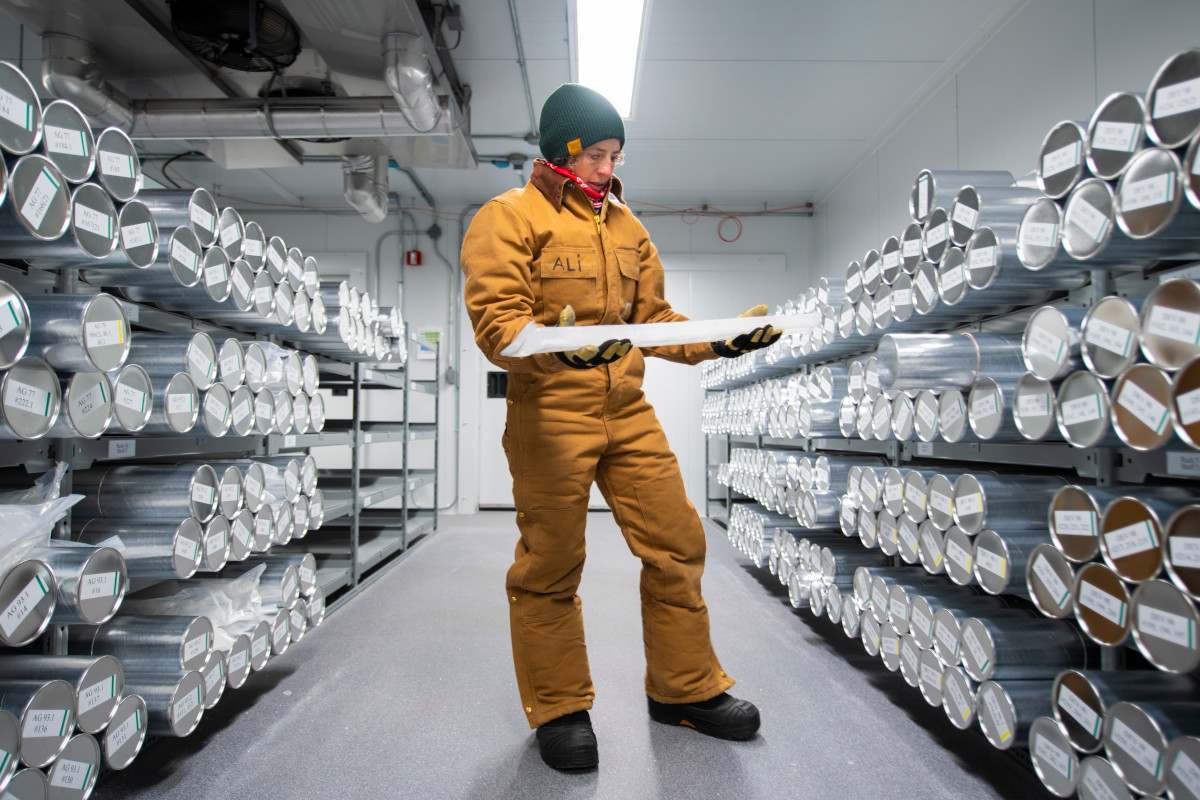
Alison Criscitiello, director of the Canadian Ice Core Lab, holds an ice core in the lab. Learn from her about the incredible science coming from beneath the ice in the third Science Connects webinar. Photo credit: John Ulan
A wealth of scientific data about the history of climate and pollutants trapped deep under layers of ice. A potential salty biome of underwater life in a subglacial lake that has never seen the light of day. These were just a few of the research projects shared in a webinar by Alison Crisctitiello, University of Alberta researcher and director of the Canadian Ice Core Lab in the Faculty of Science.
The presentation, Stories From the Ice: Perspectives from New Canadian Arctic Ice Cores, was the third in the Science Connects webinar series—a new initiative connecting researchers in the Faculty of Science with alumni and community members across Alberta, Canada, and around the world, helping demystify science research.
Drilling for data
So why drill ice cores in these extreme environments?
“Ice cores allow us to investigate past climate and environmental conditions prior to the late 1970s, when the satellite era began, making them one of our most powerful tools for studying Earth, climate, and how humans have affected both,” explained Criscitiello.
The chemistry of ice cores yields insight into the history of nuclear weapons testing, temperature changes, volcanic eruptions, forest fires, and even pollutants and pesticides. But uncovering that important historical record requires serious scientific expertise and some equally impressive equipment, explained Criscitiello, showing the audience footage of the drills at work and describing the challenges of transporting the ice cores back to the lab without letting them thaw.
Science on ice
“There are a lot of compelling results coming from studies in the Canadian Arctic,” said Criscitiello, “including subglacial lakes beneath the Devon Ice Cap, environmental contaminants in the Canadian Arctic, and reconstructing sea ice variability in the Arctic using new ice cores.”
Criscitiello’s presentation drilled down into how these subglacial lakes could provide the closest Earthly analogue for extraterrestrial environments like those of Jupiter’s moon Europa and Saturn’s moon Enceladus. The lakes were discovered by former University of Alberta PhD student Anja Rutishauser.
Exploring recent scientific results with the audience, Criscitiello explained how ozone-depleting chlorofluorocarbon (CFC) replacements are a source of persistent organic pollution in the Canadian Arctic and how her research has found degraded, toxic compounds from these replacements in the ice.
Criscitiello also gave the audience a preview of some upcoming expeditions planned by her and her team, including an expedition to the summit of Mount Logan—the highest mountain in Canada and second-highest peak in North America—to extract a core that could contain some of the oldest Arctic glacial ice on Earth.
“This is an incredibly exciting time for ice core science in Canada,” said Criscitiello. “We’re thrilled to help advance the field at Canada’s national ice core lab, located right here at the University of Alberta.”
If you couldn’t make it to the live webinar, watch the full recording to hear from Criscitiello.
Visit our calendar to find information on similar events, including live talks and webinars, or check out the Office of Alumni Relations’ On Demand offerings.
Want to learn more about the Canadian Arctic, mountains, and other science topics? We also offer many free Massive Open Online Courses (MOOCs) to keep you learning and engaged, like Astro 101, Bugs 101, Dino 101, and Mountains 101. For information on how these courses align with Alberta’s K-12 curriculum, please see this useful guide.